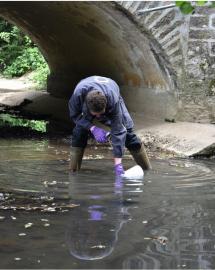Environmental monitoring: more than a regulatory requirement
Environmental monitoring is Andra's responsibility to the territories hosting its facilities. Here are some explanations.

Like any industrial activity, radioactive waste management is not without impact. The management and disposal of this waste can lead to the release of very small quantities of radioactivity and chemical elements into the environment, which can have an impact on humans and their environment. "Our facilities are designed, built and operated to limit our environmental impact as much as possible," emphasises Sophie Dinant, director of Andra's environmental safety department." Monitoring releases and the environment at our sites is an essential tool that enables us to check that our impact remains as low as possible."

Noues d'Amance, near the
Aube disposal centre.
For basic nuclear installations (INB) such as the disposal facilities in La Manche, Aube and Cigéo in the future, if the latter is authorised, it is governed in particular by the so-called "environmental" decision of the Nuclear Safety Authority (ASN) and by prescriptions concerning discharges taken today by decree, and eventually by the ASN, which imposes in particular the controls and analyses to be carried out. For installations classified for environmental protection (ICPE), such as the Industrial Centre for the Grouping, Storage and Disposal of Waste (Cires), it is a prefectoral decree, based on the monitoring elements recommended by the Regional Directorate for the Environment, Planning and Housing (DREAL), which imposes the sampling and monitoring to be carried out.
Among the provisions that Andra must follow is the carrying out of an initial environmental assessment. Before any facility is built, numerous samples are taken in order to obtain measurements that will be used throughout the operation of the facility and even after its closure. These reference measurements make it possible to keep track of the physico-chemical and radiological state of the environment. They are then compared with the measurements carried out as part of the monitoring of the facilities and allowconfirmation of the negligeable impact of their activities.
A responsibility towards the territories and their populations

Manche disposal facility
In addition to the regulatory constraints, Andra imposes more restrictive constraints on itself by setting objectives well below the regulatory limits set by the authorities. "There is also what we are doing to answer the questions of local residents as best we can," explains Sophie Dinant. "This is very important. We owe our neighbours information that is as close to them as possible, very accessible and that answers their questions. For example, we sometimes include new control points in the groundwater to clearly demonstrate that there is no pollution or problematic transfers linked to our activities."
And to ensure this scrupulous monitoring, Andra employs hydrogeologists, metrology specialists, chemists, biodiversity experts and environmental engineers. All this expertise guarantees the rigour and quality of the environmental monitoring at its facilities.
EXPERTISE WITH A WEALTH OF INFORMATION FOR THE FUTURE
The environmental monitoring of the Aube and Manche disposal sites provides knowledge basis and proven expertise that will be used as feedback for the Cigéo environmental monitoring plan, if the project is authorised.
3 questions to... Nathalie Reynal (ASN)
Assistant to the Director of Environment and Emergencies at the French Nuclear Safety Authority (ASN).
Monitoring plan and discharge limits: what the regulations say
What rules does the ASN impose on Andra regarding environmental monitoring?
The regulations imposed on Andra are the same as those that apply to all basic nuclear facilities (BNI). It requires the definition and implementation of monitoring of their releases, as well as monitoring of the environment likely to be affected by the facility.
A regulatory decision taken by the ASN in 2013, commonly known as the "environmental decision", sets out the monitoring programme to be implemented (sampling and analysis, frequencies, alerts and information obligations, etc.). It must then be adapted to the specific characteristics of the installations, the site and the environment.
How are release thresholds and authorisations set?
For each nuclear facility, the operator formulates a proposal for limit values based on actual or projected releases from the facility, demonstrating that the impact associated with these values is very low and optimised.
The ASN then ensures that the operator implements the best available techniques and finally sets the limit values. It should be noted that as far as chemical substance releases are concerned, the ASN ensures that the thresholds set for BNIs are consistent with those imposed on ICPEs (editor's note: these are set by the DREAL and the prefect).
How does the regulation adapt to the evolution of the installations?
Throughout the life of an BNI, the ASN may revise the decisions governing discharge limits and the methods of withdrawal and discharge, either on its own initiative or at the request of the operator when there is a significant change to the facility.
Independently of these possible revisions, the operator is required, during periodic reviews, to re-examine the implementation of the best available techniques and to present feedback on actual discharges in relation to the limit values, to enable the ASN to revise these limit values if necessary.

